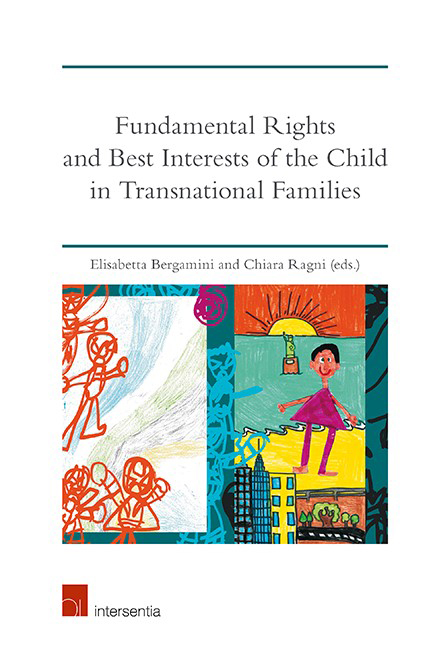Book contents
- Frontmatter
- Dedication
- Preface
- Acknowledgements
- Contents
- List of Cases
- List of Authors
- PART I THE IMPACT OF HUMAN RIGHTS AND OF THE BEST INTERESTS OF THE CHILD ON EU FREE MOVEMENT AND MIGRATION LAW
- Human Rights of Children in the EU Context: Impact on National Family Law
- Protecting EU Citizen Minors' Right to Identity in the Transnational Family Context
- The Best Interests Principle's Impact on Decisions Concerning Asylum-Seeking and Refugee Children
- Human Rights and the Best Interests of the Child in European Family Reunification Law
- Rainbow Families and EU Free Movement Law
- Kafala and Family Reunification of Third-Country Nationals
- Against a Girl's Will: Child Marriages, Immigration and the Directive on Family Reunification
- PART II THE BEST INTERESTS OF THE CHILD AS A CONCERN OF HUMAN RIGHTS AND EUROPEAN PRIVATE INTERNATIONAL LAW
- Index
- About the Editors
Against a Girl's Will: Child Marriages, Immigration and the Directive on Family Reunification
from PART I - THE IMPACT OF HUMAN RIGHTS AND OF THE BEST INTERESTS OF THE CHILD ON EU FREE MOVEMENT AND MIGRATION LAW
Published online by Cambridge University Press: 12 November 2019
- Frontmatter
- Dedication
- Preface
- Acknowledgements
- Contents
- List of Cases
- List of Authors
- PART I THE IMPACT OF HUMAN RIGHTS AND OF THE BEST INTERESTS OF THE CHILD ON EU FREE MOVEMENT AND MIGRATION LAW
- Human Rights of Children in the EU Context: Impact on National Family Law
- Protecting EU Citizen Minors' Right to Identity in the Transnational Family Context
- The Best Interests Principle's Impact on Decisions Concerning Asylum-Seeking and Refugee Children
- Human Rights and the Best Interests of the Child in European Family Reunification Law
- Rainbow Families and EU Free Movement Law
- Kafala and Family Reunification of Third-Country Nationals
- Against a Girl's Will: Child Marriages, Immigration and the Directive on Family Reunification
- PART II THE BEST INTERESTS OF THE CHILD AS A CONCERN OF HUMAN RIGHTS AND EUROPEAN PRIVATE INTERNATIONAL LAW
- Index
- About the Editors
Summary
INTRODUCTION AND SCOPE OF ANALYSIS
Family reunification constitutes one of the main reasons for immigration into the European Union (EU). This chapter reflects on a specific aspect of migration issues, i.e. the manner and extent to which the prohibition of child marriages as affirmed at the international level can limit family reunification in the EU. Directive 2003/86/EC on the right to family reunification is the key legal instrument in this respect; it leaves States discretion in requiring the sponsor and his/her spouse to be of a minimum age ‘before the spouse is able to join him/her’ (Article 4(5)). The provision was interpreted by the European Court of Justice, which considered the decision of a State to assess the age limit at the time of the application for family reunification to be legitimate.
This chapter argues that the prohibition of forced child marriages always constitutes a limit to family reunification, even when the spouse, sponsor, or both, has reached the minimum age for reunification. Moreover, it is contended that child marriages are forced – hence not a ground for family reunification – in all cases in which they constitute gender-based violence against women and girls, as defined at the international level: this is the case of a marriage between a girl and a male adult. To support the main argument, this chapter relies on the recent Council of Europe Convention on preventing and combating violence against women and domestic violence (Istanbul Convention) of 2011, 3 which the EU has signed but not yet ratified. The Convention enshrines pivotal provisions prohibiting forced marriages, and these can be applied in cases of child marriages.
This analysis is guided by the best interest of the child, a principle clearly recognised at the international level and codified in Article 24 (2) of the EU Charter of Fundamental Rights. Despite being aware of the existence of child marriages that involve boys, the focus here will be on female brides because girls are disproportionately affected by the practice.
The analysis begins with a definition of and some data on child and forced marriages before investigating the main legal instruments that contain the prohibition of the practice and outline the child ‘s basic human rights that are thus violated.
- Type
- Chapter
- Information
- Publisher: IntersentiaPrint publication year: 2019

